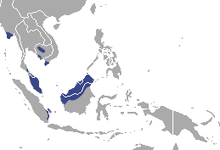Hair-nosed viper
| Hair-nosed viper | ||||||||||||
|---|---|---|---|---|---|---|---|---|---|---|---|---|

Hair-nosed viper ( Lutra sumatrana ) |
||||||||||||
| Systematics | ||||||||||||
|
||||||||||||
| Scientific name | ||||||||||||
| Lutra sumatrana | ||||||||||||
| ( Gray , 1865) |
The hair-nosed viper ( Lutra sumatrana ) is a mammal from the marten family . It is the rarest and least researched of the five otters (subfamily Lutrinae) found in East Asia . Due to human persecution and habitat destruction , the hair-nosed viper is classified as endangered by the IUCN .
description
Hair-nosed otters are medium-sized otters, the body length is about 1.3 m, the weight around 7 kg. Complete webs are formed between the strong clawed toes. The fur is dark brown on top and a little lighter on the underside. The chin and upper lip are sharply set off whitish cream. The entire nasal region is short and darkly haired.
distribution and habitat
The range of the species covers parts of Southeast Asia and is not yet exactly known. Reliable evidence has been provided in Thailand , Cambodia , Vietnam , Malaysia , Brunei and in the Indonesian part of Sumatra over the past 20 years , and in the 1980s also from various other localities in northern Borneo . Historical evidence is also available for Myanmar . Possibly the area of the species covers large parts of Southeast Asia from northeast India to the east to Vietnam and to the south also the Great Sunda Islands .
According to available reports, the species inhabits swampy bog forests, the lower reaches of rivers, sea coasts and especially mangroves .
Way of life
In a swampy moor forest area in southern Thailand, 85.5% of the diet was fish; other prey animals were water-dwelling snakes, lizards, turtles, mammals and insects. So far there is hardly any information on social behavior and reproduction. The gestation period lasts about two months, as with other otters. In the Mekong Delta, the females apparently give birth to young in November and December. Puppies were seen there from December to February and in one case both parents had a young animal.
Existence and endangerment
The species is rare to very rare in its entire range. Between 1998 and 2005 the hair-nosed viper was thought to be lost and there are no data on settlement density yet. The IUCN assumes that the population has decreased by up to 50% in the last 30 years and is still declining. The main threat is human persecution in the entire area of the species. Habitat destruction through conversion is considered an additional threat in the few areas with secure occurrences in agricultural land, timber use and fires as well as a lack of suitable prey due to human overexploitation. The hair-nosed viper is therefore classified as endangered by the IUCN.
swell
Individual evidence
- ^ Otter Specialist Group 2009: Lutra sumatrana (Gray, 1865), the Hairy-Nosed Otter. ( [1] Online, accessed December 31, 2010)
Web links
- Lutra sumatrana in the endangered Red List species the IUCN 2010. Posted by Hussain, SA, Kanchanasakha, B., de Silva, PK & Olson, A., 2008. Accessed on December 30 of 2010.
- Otter Specialist Group 2009: Lutra sumatrana (Gray, 1865), the Hairy-Nosed Otter. ( [2] Online, accessed December 31, 2010)
